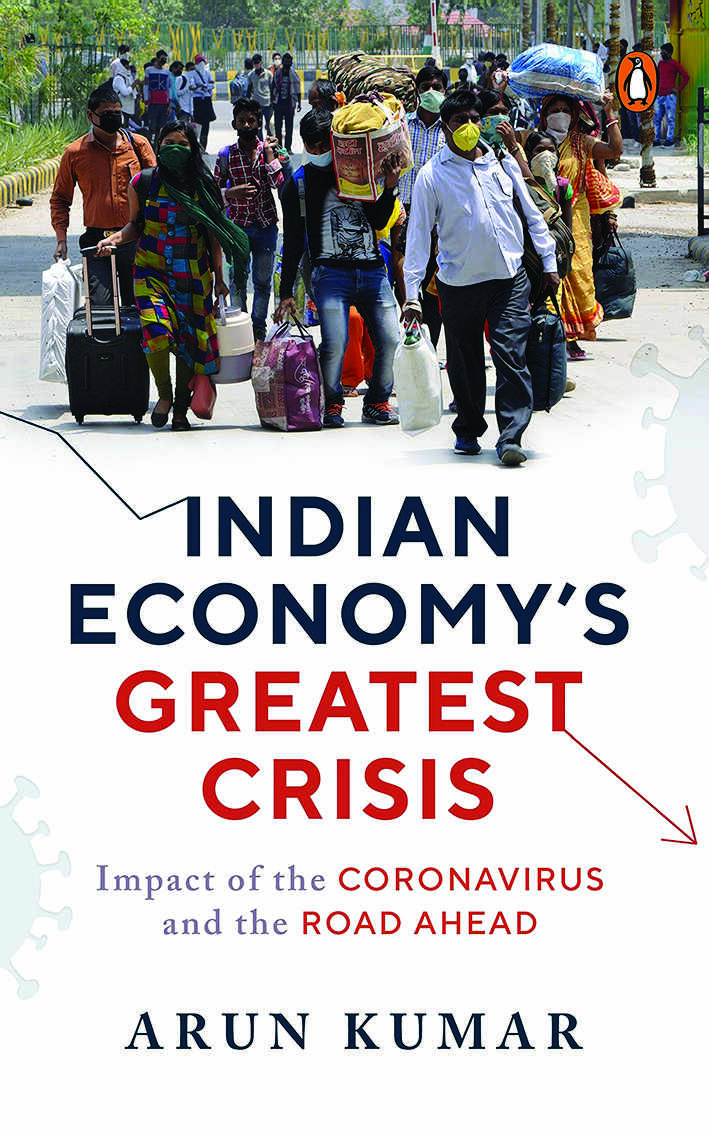"Indian Economy’s Greatest Crisis" | Crisis on multiple fronts
Making a compelling argument that an economy is not like a rubber ball, which, if dropped on a hard surface, will bounce back to its original position, Indian Economy’s Greatest Crisis provides incisive reasons to why economic recovery will be slow and not ‘V-shaped’; Excerpts:
Author: Arun Kumar
Publisher: Penguin
By mid-March, the government realized that a lockdown had become inevitable to control the spread of the disease. Some states started implementing lockdowns in mid-March. The one-day janata curfew organized on Sunday, 22 March, was in preparation for a nationwide lockdown from 25 March. The lockdown was further extended, with some relaxations on 14 April, and then in various phases through May. These were followed by Unlock 1 in June and subsequent phases of unlock after that. Increasingly, more and more activity was permitted.
As mentioned in Chapter I, a lockdown is not the cure to a disease but serves two important purposes. First, it slows down and, in some cases, halts the spread of the disease in the country and, second, it buys the government time to put in place the healthcare infrastructure needed to meet any eventuality that may arise. But, as discussed in Chapter III, the lockdown administered a big shock to the economy, especially hitting the unorganized sectors that exist on the very edge of survival. Thus, India had to confront two emergencies simultaneously—a health crisis and an economic one.
As argued in Chapter IV, while the lockdown was implemented, the preparation required for it to be a success was missing. Namely there was a need to:
Take care of the poor by making essentials available to them wherever they were.
Decongest the poor in the cities so that their isolation could become feasible.
Initiate a massive programme of testing and contact tracing to slow the spread of the disease.
Prepare and create the healthcare infrastructure needed to take care of those who got infected.
Prevent potential business failures on a large scale.
A package encapsulating all of this was needed. The government, however, did not put such a package in place and the lockdown was only partially successful. It did help reduce the rate at which the disease spread but it did not control it. As argued in Chapter IV, in India, the pandemic kept spreading; the lockdown had to be partially reimposed in some areas, restrictions could not be eased quickly in large parts of the economy and the revival of the economy became difficult.

The health and the economic emergencies became dire for every section of the population. There was enormous pressure on the government to act so the situation did not spin out of control. The government’s own financial situation deteriorated and demands on its resources increased, leading to policy difficulties. In the absence of a clear-cut thought process, there was much confusion in policy. Priorities were not re-evaluated and policymakers acted as if they could continue to do what they had been doing earlier, only a bit more. But, along with other experts—both national and international—they were behind the curve.
Government Intervention: Steps Undertaken Globally
The governments in the advanced countries were quick to announce substantial relief packages. They saw that unemployment was shooting up and businesses failing. The US first gave $8.3 billion in early March, followed by a $100-billion emergency aid package in mid-March and a $2-trillion rescue package at the end of March. It provided money to individuals, funds for healthcare facilities and aid to businesses strapped for cash. Subsequently, at the end of April, another $480 billion was sanctioned to help the economy.
The total package amounted to about $2.5 trillion. Individuals earning less than $75,000 were to get $1200 and $500 for each child. Small businesses were to receive money to pay salaries under the Paycheck Protection Program (PPP). So a package of about 15 per cent of the GDP (reduced due to the depression in the economy) covered most sections of the economy and was given directly from the budget. The total deficit in the budget was estimated to climb to about 19 per cent of the GDP. This was in addition to the monetary policy steps announced by the central bank (Federal Reserve System). It provided for liquidity and cuts in interest rates to boost the economy. At the beginning of March, the rate of interest was cut to 0.5 per cent and then to 0 per cent. Liquidity was made available to municipalities and firms.
Japan, by end of April, had announced a programme of $1.1 trillion, of which $452 billion was to come from the budget. Thus, a stimulus of about 10 per cent of the GDP (reduced) was to come from the budget. The UK, in April, announced a rescue package that was 15 per cent of the GDP to support businesses.
Segal and Dylan (2020) report that G20 as a whole, at a virtual meeting on 26 March, committed to spending $5 trillion (7.4 per cent of the 2019 GDP). By the end of April, the figure went up to $6.3 trillion, or 9.3 per cent of the 2019 GDP. Of this, $3.2 trillion (4.8 per cent of the GDP) was to be from the budget. The rest was credit enhancements and tax relief. Segal and Dylan also point out that the response to the economic crisis this time has been far quicker than during the global financial crisis in 2007–09. Further, they also point out that the emerging-market economies have announced a much smaller package than those of developed countries, perhaps due to fiscal constraints.
The packages announced globally consist of the following elements:
Increased government expenditures leading to an increased fiscal deficit
Loans to existing businesses to tide over these difficult times
Loans/grants to businesses to pay at least part of the wages to workers
Cash transfers to people who have had to face pay cuts
Starting of public works for the unemployed
Tax concessions to businesses to boost profits
Let us discuss each of these to understand their content, intent and impact on the economy.
Increasing Fiscal Deficit
Government expenditures lead to higher demand in the economy. But when revenue is collected to finance the expenditure, it reduces the purchasing power of those paying taxes. An excess of expenditures over revenues of the government is called the fiscal deficit. In other words, fiscal deficit is the situation in which the government spends more than its revenues. So, crudely speaking, demand in the economy increases by the extent of the fiscal deficit (Kalecki, 1971 and Kumar, 1988).
As mentioned in Chapter III, incomes fall drastically during a lockdown, which means tax collections also fall sharply. But expenditures rise to take care of the various needs of businesses, workers and medical expenses. The result is a sharp rise in the fiscal deficit in the budget of the government. For the US, the UK and Japan, the rise in deficit based on increased expenditures is 10–20 per cent of the GDP (Table V.1). This is not counting the likely decline in the revenues due to the decline in incomes. So,
for most advanced economies, the rise in the fiscal deficit could be anything between 15–25 per cent of the GDP.
In the post-1980s’ world, a high fiscal deficit was frowned upon, since it was supposed to limit the freedom of the private sector and crowd out private investment by pre-empting resources. An arbitrary number, 3 per cent of the GDP, has been fixed to be the right amount of fiscal deficit for an economy. In India, also under the Fiscal Responsibility and Budget Management (FRBM) Act, 2003, this number has been declared to be the target the government should aim for. But the government has seldom achieved it.
In today’s conditions, when the lockdown has led to a collapse in demand (Chapter III), most analysts are calling for a high fiscal deficit to boost the economy—to stimulate growth. Even businessmen and those in the finance sector who have traditionally been opposed to raising the fiscal deficit see virtue in now raising it. Kumar (2020i) argues that the massive deficit will neither create inflation nor crowd out private investment under the present circumstances.
Loans to Existing Businesses
Chapters II and III point out that many small businesses or those that are highly leveraged and have little reserves, begin to fail when they have to shut down during a pandemic. They all have loans on which they have to pay interest and repay the loans they may have taken to set up the business. With no revenue coming in due to closure of the business, these companies lack the funds to either pay interest or any part towards repayment of the loans, and subsequently go into default. This creates a non-performing asset (NPA) for the banks and lending institutions, and this can also result in business failure.
If a large number of businesses collapse, the revival of the economy after a lockdown will be difficult, and may even be impossible. In the current situation, to prevent businesses from collapsing, the governments have announced loan packages to businesses and the central banks have offered additional liquidity. A moratorium on the repayment of loans and interest payment has also been announced so that businesses can pay the money they owe the banks after a certain number of months. The idea is that, by then, the businesses will pick up again and start generating revenue. In India, a sixmonth moratorium was allowed. But this only postpones the day of reckoning, since the interest will keep mounting. Interest on funds not repaid will also mount. In October, the government, prodded by the Supreme Court, offered to take the burden of the extra interest on the unpaid loan. If a business, when it restarts, makes little profit since demand is low, it will still not have the funds to pay the creditors and will eventually fail. Thus, for such businesses, the day of reckoning is only postponed.
The alternative is that a loan is given to the business by the government, and that is converted into equity when the business restarts. This is a more viable strategy. It is suggested that the equity be sold by the government in a few years, when the business gets going. It is also said that this way, the government also gains a certain premium. But this is going to be a messy situation if the governments have to take care of their investment in millions of businesses.
This scheme may also encourage crony capitalism, with the well-connected cornering a large share of the loans and many others not getting loans even if they are viable. In India, this could result in an increase in fraud.
If businesses collapse in spite of the loan, if demand does not pick up soon, the government will stand to lose the money it invested in these businesses. This is the reason banks are not lending to weak businesses even though liquidity has been pumped into the system to allow liberal lending. The chances are that many weak businesses will fail despite the loans being offered.
(Excerpted with permission from Indian Economy’s Greatest Crisis by Arun Kumar; published by Penguin Random House)



